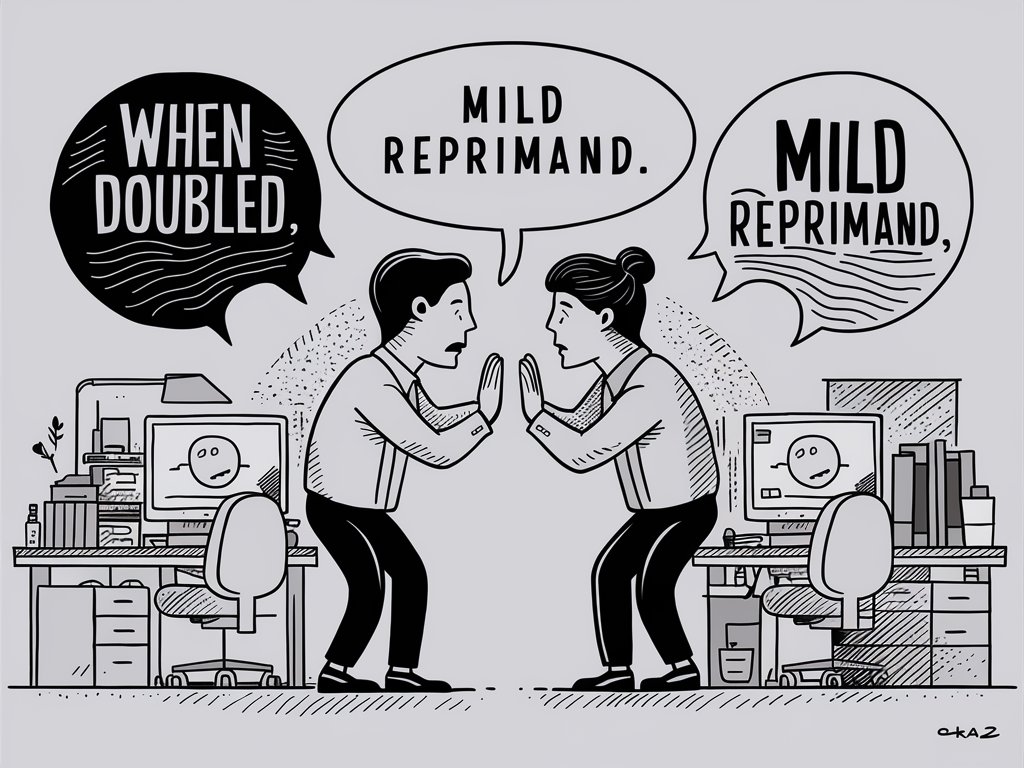In many parts of life, like raising kids, working in offices, and dealing with others, sometimes you have to scold. A reprimand, at its core, is a corrective measure meant to address abominable behavior or actions. However, the manner in which a reprimand is delivered significantly impacts its effectiveness and the recipient’s response. This brings us to the intriguing concept of “when doubled, a mild reprimand.”
The Art of Reprimanding: Striking a Balance
Understanding Reprimands
A reprimand is a form of feedback given to individuals when their behavior or performance deviates from expected standards. It aims to help people understand and learn from their mistakes so they can avoid making them again in the future. Reprimands can range from mild to severe, depending on the nature and gravity of the misconduct.
The Concept of “When Doubled”
The phrase “when doubled” suggests amplifying the effect of a mild reprimand by strategically repeating or reinforcing it. This doesn’t mean shouting or becoming harsh but rather employing subtle techniques to ensure the message is conveyed effectively. The goal is to strike a balance where the reprimand is firm yet considerate, impactful yet not demoralizing.
The Psychology Behind Mild Reprimands
Positive Reinforcement
Mild reprimands, when delivered correctly, can serve as a form of positive reinforcement. By gently pointing out the mistake and suggesting improvements, the individual feels supported rather than attacked. This approach fosters a growth mindset, encouraging continuous learning and development.
Cognitive Dissonance
Cognitive dissonance occurs when there is a discrepancy between one’s actions and self-perception. A gentle reminder, when repeated, can make someone rethink their actions and act in line with how they see themselves. This internal conflict often leads to self-correction and improved performance.
Techniques for Doubling Mild Reprimands
1. Reiteration with Variation
Reiterating the reprimand with slight variations in wording or context helps reinforce the message without sounding repetitive. For instance, if an employee is frequently late, they might get a friendly reminder about the importance of being punctual. A follow-up could involve discussing how their lateness affects the team, thereby emphasizing the point without direct repetition.
2. Sequential Feedback
Providing feedback in stages ensures that the message is absorbed and acted upon. Begin by gently correcting the person, allow them time to make changes, and then provide another gentle correction if needed. This sequential approach prevents overwhelming the recipient and promotes gradual improvement.
3. Incorporating Positive Feedback
Balancing the reprimand with positive feedback creates a constructive atmosphere. For instance, acknowledge the individual’s strengths and contributions before addressing the areas needing improvement. This method softens the impact of the reprimand and motivates the individual to make necessary changes.
Practical Applications of Doubling Mild Reprimands
In Parenting
Parents often face the challenge of correcting their children’s behavior without damaging their self-esteem. Doubling mild reprimands can be particularly effective here.
For example, if a child neglects their homework, a parent might initially remind them of their responsibilities. If the behavior continues, have another talk to set clear rules and consequences. Remind them of the first warning without resorting to severe punishment.
In Education
Teachers play a crucial role in shaping students’ behavior and attitudes. Mild reprimands, when doubled thoughtfully, can help maintain classroom discipline while nurturing a positive learning environment.
For instance, a teacher might first address a disruptive student with a gentle reminder of classroom rules. If the behavior continues, the teacher will discuss the importance of respect and teamwork to reinforce the consequences. This discussion aims to help students understand the reasons behind the rules. It also serves as a reminder of the expectations for behavior in the classroom. Ultimately, the goal is to encourage positive behavior and create a respectful learning environment.
In the Workplace
Managers and leaders often need to address employee performance issues. A mild reprimand can be an effective tool when used correctly. For instance, if an employee misses a deadline, a manager might initially discuss the importance of timely submissions. If deadlines are missed again, the manager could revisit the conversation, this time highlighting the impact on the team and suggesting practical solutions to avoid future delays.
Also Read: Cat in the Chrysalis Spoiler: An In-Depth Analysis
Benefits of Doubling Mild Reprimands
1. Enhanced Communication
Doubling mild reprimands fosters open communication. It shows that the person delivering the reprimand is willing to engage in an ongoing dialogue rather than issuing a one-time scolding. This approach builds trust and encourages the recipient to seek clarification and feedback.
2. Reduced Resistance
People are more likely to respond positively to gentle corrections than to harsh criticism. Doubling mild reprimands reduces the likelihood of defensive reactions and promotes a cooperative attitude. The recipient feels respected and understood, making them more receptive to change.
3. Sustainable Behavior Change
The gradual reinforcement of mild reprimands leads to sustainable behavior change. Rather than imposing immediate, drastic measures, this approach allows individuals to adapt and improve at a manageable pace. It fosters long-term growth and development, benefiting both the individual and the organization or relationship.
Challenges and Considerations
1. Consistency is Key
For doubling mild reprimands to be effective, consistency is crucial. Inconsistent feedback can confuse the recipient and undermine the effectiveness of the reprimand. It’s important to follow up and ensure that the message is reinforced appropriately.
2. Cultural Sensitivity
Cultural differences can influence how reprimands are perceived and responded to. It’s important to consider cultural norms and values when delivering and doubling reprimands. What might be considered a mild reprimand in one culture could be perceived as harsh in another.
3. Balancing Firmness and Gentleness
Striking the right balance between firmness and gentleness can be challenging. The reprimand should be firm yet respectful to emphasize the importance of the correction while preserving positive relationships. This balance requires empathy, emotional intelligence, and effective communication skills.
Conclusion
The concept of “when doubled, a mild reprimand” offers a nuanced approach to correction and feedback. By strategically reinforcing mild reprimands, we can promote positive behavior change without resorting to harsh measures. This method creates a supportive environment where individuals feel valued and motivated to improve.







